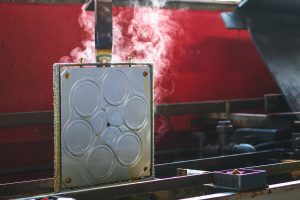Chrome plating is a treatment that began to be used by rubber moulders in the late 1990s. Before then, a mould for technical rubber article had to be reworked whenever it wore out. Chrome-plating is the treatment that allowed to extend the moulds’ life, protecting surfaces from rubber abrasion. Thanks to chrome-plating, moulders reduced investments in new moulds and more: they obtained higher-quality technical rubber article.
In our company we introduced an in-house unit dedicated exclusively to the chrome plating of moulds. In this area we chrome-plated more than 50.000 moulds and we confront many moulding-companies.
So, we decided to share 5 questions about chrome-plating we frequently receive:
1. How can the mould thickness be measured?
Chrome measurement is carried out with a ‘thickness gauge’. This instrument allows the chrome deposition layer on the surface to be detected. It is necessary to reset the thickness gauge at each new measurement, before putting the mould in the tank, in order to calculate the amount of deposited chromium at the end of the cycle.
2. When is it not possible to chrome?
In most cases it is possible to chrome-plate the mould. The only limitation to the feasibility of chrome-plating are narrow and deep parts, where the chrome may not reach and deposit unevenly. In fact, for some moulds for technical rubber articles it is often necessary to build special equipment to be able to chrome-plate the mould.
3. How does chrome-plating help reduce rubber parts wastage?
By improving the detachment conditions: if it is difficult to detach the piece from the mould, it can be that the product may tear and consequently must be discarded. By chrome-plating the mould, the parts can be more easily released, minimising any defects.
If you have some other questions about chrome-plating ad you would like to deepen the features of the chrome and its potentialities, you can require our digital guide.




